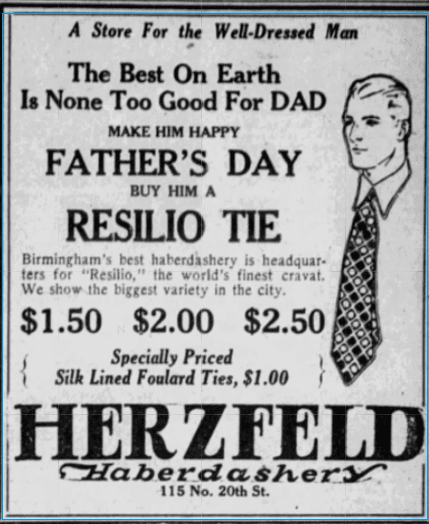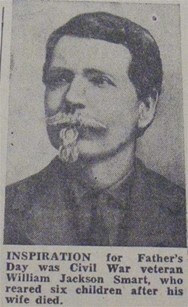12 Jun Genealogist for Hire- June 12, 2021

A count of families in the fifteen slave-holding states in 1860:
▪ 73,230 members of families holding 50 or more slaves or 1%
▪ 986,895 members of families holding 5 – 49 slaves or 12%
▪ 931,280 members of families holding 1 – 4 slaves or 11%
▪ 6,120,825 non-slaveholding whites or 75%
I would not have guessed that 75% of “southern families in 1860” were not slaveholders.
Contents
 The Man Who Inspired Father’s Day Was a Single Dad and a Civil War Vet
The Man Who Inspired Father’s Day Was a Single Dad and a Civil War Vet
written by John D. Trausch
Father’s Day is a relatively new holiday, having only become “official” in 1972. But its origins go back to a Civil War veteran.
The holiday’s inspiration was William Jackson Smart, a twice-widowed father of 14. Smart was also a double-Civil War veteran—meaning he fought for both sides.
Smart, from Arkansas, was a 19-year-old driving a supply wagon for Confederacy when he has captured by the U.S. at the Battle of Pea Ridge in 1862. What happened next is unclear, but Smart soon reemerged as a soldier fighting for the Union. Smart was one of more than 100,000 Southerners who rejected the Confederacy and fought for the U.S. during the Civil War. (Every Southern state except South Carolina raised at least a battalion to defend the U.S.)
After the war, Smart married and started his family. After his first wife died, Smart and his second wife relocated to eastern Washington in the late 1880s.
Years later, one of Smart’s daughters, Sonora Smart Dodd of Spokane, Washington, wondered that since there was a Mother’s Day celebrating all things maternal, why not a Father’s Day?
“He was both father and mother to me and my brothers and sisters,” Sonora later told the Spokane Daily Chronicle. “I remember everything about him!”
In 1910, Sonora petitioned local churches, the YMCA, shopkeepers, and politicians to recognize dear old dads. Her idea caught on, and Washington State celebrated the nation’s first statewide Father’s Day on June 19, 1910.
Mother’s Day was always more popular, and that holiday, thanks largely to the retailers who lobbied to make that day official. President Woodrow Wilson had approved a Mother’s Day resolution in 1914 in honor of “that tender, gentle army, the mothers of America.”
Father’s Day was a tougher sell, perhaps, as one florist lamented, “fathers haven’t the same sentimental appeal that mothers have.”
Sonora continually pushed for a national Father’s Day. Her efforts caught the attention of William Jennings Bryan, a three-time presidential nominee and Secretary of State, who sent Sonora a letter of support, creating more momentum for the day.
Slowly, the Dad’s Day idea spread. In 1916, on an odd demonstration of then-modern technology, Wilson honored the day (not a holiday yet) in Washington, D.C. by pressing a button, which signaled telegraph signals to be sent to Spokane, where a flag was unfurled.
In the 1920s, a movement arose to combine Mother’s Day and Father’s Day to favor a single Parents’ Day. The idea was continued in the Great Depression when retailers wanted to make Father’s Day a “second Christmas” for men, to encourage sales of ties, hats, socks, pipes and tobacco, and golf clubs…”
Sonora spent much of the next 60 years pushing for the official recognition of Father’s Day as a national holiday. But it wasn’t until 1972 that President Richard Nixon signed a Congressional resolution finally making Father’s Day a federal holiday in the midst of his re-election campaign. Sonora, who would live until 1978, was then 90 years old. Today, economists estimate that Americans spend more than $16 billion each year on Father’s Day gifts.
 The Headright Grant and Early Forts
The Headright Grant and Early Forts
An excerpt from “The Earliest Settlements in Virginia were by Headright Grants,” by Jeannette Austin.
“The headright grant was the most important land grant. It became the principal basis for title to land in the seventeenth century. The origin goes back to the Great Charter of 1618.”
“That for all persons, which during the next seven years after Midsummer Day 1618 shall go into Virginia with intent there to inhabit If they continue there three years or die after they are shipped there shall be a grant made of fifty acres for every person upon a first division and as many more upon a second division (the first being peopled) which grants to be made respectively to such persons and their heirs at whose charges the said persons going to inhabit in Virginia shall be transported with reservation of twelve pence yearly rent for every fifty acres to be answered to the said treasurer and company and their successors forever after the first seven years of every such grant.”
The headright grant of fifty acres per person was open to shareholders who brought settlers into the colony and to anyone who had migrated to the colony at his own expense or who had financed the expedition of other persons. Individuals paying for their own transportation were entitled to fifty acres for themselves and every family member, providing they fulfilled the residence requirement of three years. This is how so many early settlers became large landowners of thousands of acres.
The headright was discontinued by the crown in 1624. However, the royal governors continued to honor headright claims based upon immigration. It became the custom. Sadly, most of the early settlers were wiped out by the Indians in 1623/1624.
Forts and The Granting of Land
After the Indian massacre of 1623/4, the land was granted on a large scale to establish forts. By an Order of the Assembly in 1645, blockhouses or forts were established at strategic points: Fort Charles at the falls of the James River, Fort Royal at Pamunkey, Fort James on the ridge of Chickahominy on the north side of the James, and in the next year Fort Henry at the falls of the Appomattox River. Since the maintenance of these forts was so expensive, the officials decided to prevent the draining of the public treasury by granting forts with adjoining lands to individuals who would accept the responsibility of their upkeep and the maintenance of an adequate force for defense. Fort Henry, located at present-day Petersburg, was granted to Captain (later General) Abraham Wood with 600 acres of land plus all houses, edifices, boats, and ammunition belonging to the fort. Captain Wood was required to maintain and keep ten persons continuously at the fort for three years. During this time, he was exempted from all public taxes for himself and the ten persons. Lieutenant Thomas Rolfe, son of Pocahontas and John Rolfe, was offered the same terms, and he received Fort James and 400 acres of land; Captain Roger Marshall, Fort Royal, and 600 acres. Since there was no arable land adjoining Fort Charles at present-day Richmond, other inducements were made for its maintenance.
All of these forts served as the first line of defense against possible attacks by the natives. Being the center of the varied activities of the frontier, they also were the starting point for expeditions against the Indians. They became the center of trade for the outlying regions.
 Still don’t know what to get dad for Father’s Day?
Still don’t know what to get dad for Father’s Day?
One of my kids gave me StoryWorth as a gift, and I have become a fan. My clients are supportive of capturing their family legacy but struggle to gather their own stories. Here is an inexpensive way to help them capture and preserve excerpts to their story. If you look, there is a Father’s Day coupon out on the internet. If you sign up, please enter DancestorsGenealogy as who referred you!


 The Man Who Inspired Father’s Day Was a Single Dad and a Civil War Vet
The Man Who Inspired Father’s Day Was a Single Dad and a Civil War Vet The Headright Grant and Early Forts
The Headright Grant and Early Forts Still don’t know what to get dad for Father’s Day?
Still don’t know what to get dad for Father’s Day?